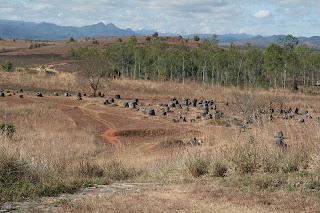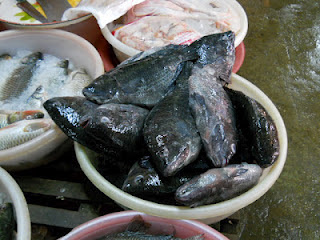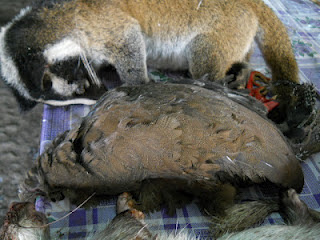 Heavy mist engulfed the whole of Phonsavan's town this morning with visibility of less than a kilometre.
Heavy mist engulfed the whole of Phonsavan's town this morning with visibility of less than a kilometre.Phonsavan is roughly about 1200 metres above sea level surrounded by lush tropical rain forest.
Traffic on the road were still very quiet except for the hive of activities at the main market area.
The pedestrian walkway was quite wide and well paved and it would be very refreshing to go for a morning walk in this cold weather.
This was about 7:00am when I made my way to the Honsava II Bus terminal hoping to catch a bus to the Vietnamese border.
Xieng Khoung Hotel was nearly covered by the thick mist and hardly to be seen despite being 500 metres away.
During the day ,temperature can be as high as 31 degree celcius while at night can drop to about 15 degree celcius.
The highest temperature will be the month of April and the lowest around December. July and August will be the wettest months.

Monks on the morning alms round.
Walking barefooted on the cold pavement is quite an enduring task and a specific discipline which is considered very practical and natural way to practice fulltime mindfulness.
By also going barefoot outside, the practice can be seen as an extension of expanding sacred space beyond the walls of the sanctuary.
The goal of any Buddist is to acheive "enlightenment" which means that any Earthly possesion had no meaning to them.
To achieve enlightenment you must stop wanting everything.
So monks believed that not having anything will relieve them of their earthly desires.
The only bus to Vinh in Central Vietnam is at 06:30am and has left.
This will only be available on Tuesday,Thursday,Friday and Sunday.
The fares is 150,000 kips.
Now my next choice is through Xam Neua border checkpoint which will be nearer to Hanoi,capital of northern Vietnam where I'll be catching my flight back home.
Minibus departure time is at 08:00am fare price is 80,000 kips.
After waiting at the empty ticketing counter for nearly half an hour,there were no signs of anyone around nor even passengers.
A Vietnamese lady baguette seller was very kind enough to direct me to this bus to Nong Het which was also a border checkpoint that leads to Vinh in Central Vietnam.
The bus driver has his wife as a ticket conductor so I paid her the 35,000 kips bus fare.
I would advise all travellers heading to Hanoi or Vinh to buy the bus tickets from your guesthouses or hotels.
As for Nong Het and Xam Neua,we can just hop in at the bus station and pay the bus conductor the fares.
Muang Nong Het is a district in North-eastern Laos bordering Vietnam via the Nam Khan(Nam Can) border passage.
Nong Het is about 150km from Phonsavan.
General Vang Pao born on December 8, 1929 in Nonghet was a venerated leader of the Hmong people who has also fought along the Ho Chi Minh Trail.
In the outskirts of Phonsavan school children were seen all along the road walking to their respective school.
Khan Khay Teachers Training College and a Khan Khay Guesthouse was also in the vicinity.
8:00am:Departure from bus terminal. 8:30am:Milestone says 120km to Nam Khan. 9:05am:Arrived Ban Nong Pet near Tham Xang Cave
9:10am:About 87km to reach Nong Het,25km to Muang Kham.
9:50am:Kham District.A small little town with a few rows of shops as in the photo. Regular songthaews and the odd bus travel between Muang Kham and Phonsavan cost 13,000 kip.
Muang Kham is at a road junction connecting to Nong Het(2 hours journey) towards the east and to Xam Neua in the north(roughly 7-9 hours journey).
 As the bus slowly climbed through the winding roads along the highlands,the sceneries were superb and pockets of Hmong communities could be seen along the way. (Hmong Community News).
As the bus slowly climbed through the winding roads along the highlands,the sceneries were superb and pockets of Hmong communities could be seen along the way. (Hmong Community News). Most of the Hmong people that comes from China are known as Miao.
Hmong New Year celebrations frequently occur in November and December (traditionally at the end of the harvest season when all work is done), serving as a Thanksgiving holiday for the Hmong people.
It was close to 12:00noon when the bus was nearing Nong Het.
The undulating hills in the surrounding areas seemed to have the effects of the Secret War bombings.
Hardly can you find tall trees and all were grown with bushes and shrubs.
Yellow flowers blended most of the landscapes.
Just across Nong Het small bus terminal,school children were seen going home after school.
There was only one regular bus parked in the compound with destination Vientiane.
Couldn't see any buses to the Nam Can border except for the many songtheaws around.
The songtheaw station leader opened a ridiculous price of 50,000 kips and I had to haggle. As I walked along the road standing in front of the post office,managed to ask one of the Lao lady staff whether the Vietnamese border is within walking distance.
The answer is a big No,you better get the songtheaw.
As I walked back to the market and bazaar area where the bus stop was just beside it,couldn't figure out which one to take so have to meet the station leader again.
This time I only agree with 30,000 kips or I don't go,will stay here till I find out from the locals.
Nong Het small market has one specialty,there were couple of tailoring shops sewing the Hmong tribal clothes and headgears.
This is very unique as you can see them sewing on the spot with made to order. Most Hmong girls in Laos today do not wear Hmong clothing in their everyday lives, but continue to do the Pa Ndau or embroidery.

Well time for my lunch and an opportunity to get some travel details to the Nam Can border.
Noodles (vietnamese:fur) is one of my favourites.
A large bowl for 5,000 kips.It's not that spicy but taste a bit sweet sour,looks like 'tom-yam' gravy.
It is advisable to order something hot and boiled so that you won't have stomach upset as precaution.
When the Hmong settlers first migrated over here from mainland China,they will stay in the highlands while the Khmu people will be at the lowland.
Many Khmu moved to Luang Prabang province and later joined the communist Pathet Lao against the many highland Hmong on the side of the Royal Lao Government.
By the time Laos became a French protectorate in 1893, the Hmong had settled in greater number in Laos and could be found not only in Xieng Kouang, but also in Sameua, Luang Prabang and Phong Saly provinces.
The system of Hmong paying tax to lowland Lao had been well established.
Not only was tax paid in the form of two silver coins per households, but those Hmong chiefs who were given village or clan leadership by the Lao such as the Kiatong, the Xophia, the Photong also had to pay occasional tribute with the product of their hunting and gathering: elephant tusks, rhinoceros horns, deer meats, etc. without counting a few kilograms of opium.
On 9 March 1945, Japanese troops occupied Laos and systematically attacked all French military and civilian strongholds.
Many local resistance French officers took refuge with the Hmong who hid them in their mountain fortress.

Finally at an agreeable songtheaw fares of 30,000kips ,I was on my way to the Nam Can border at about 1:00pm.
A few local villagers were also heading for the same destination.
The road was very winding and on the way I had a glimpse of Dindang village in the valley.
Estimated time of travel was 45 minutes to reach the Lao Immigration checkpoint but the songtheaw will only stop nearby the checkpoint.
We had to walk for a short distance along the gravel unpaved road which were badly damaged by those trailers and timber lorries.
Immigration post were closed for lunch and the lorries were parked at the narrow road blocking the access road.
Tad Kha Waterfall in Nong Het is surrounded by spectacular limestone karst.
The water runs down in cascading steps alternating with steep areas for more than 100 meters and flows all year round.
To get to the falls follow Route 7 to Nong Het, at Khang Phaniane Village turn left into a graveled road (100 km from Phonsavan) and drive for about 3 km; take the trail to the left and walk about 30 minutes to get to the waterfall. Taking a guide is recommended. Best ask at the local tourist information, or if that is closed at the Nong Het guest house.

Teak wood timber lorries transporting to Vietnam.
Nicely sawn without the tree bark. An undercover investigation by United Kingdom-based Environ- mental Investigation Agency (EIA) and Indonesian conservationist Telapak said illegal logging and timber smuggling is widespread in Laos.
Laos has many laws and regulations to control forestry industry but implementation is confused and enforcement is weak.
Smuggling of logs across the border, mainly to Vietnam, is facilitated by connections with military and officers on both sides of the border, the EIA-Telapak report said. "In Laos, the military remains a powerful institution with wide business interests, including logging, and has close links with its Vietnamese counterpart," the report said.
Vietnam has imposed restrictions on the forestry industry, reducing the supply of timber cut in natural forest from 520,000 cubic metres in 1997, when the policy was enforced, to 150,000 cubic metres last year.
Despite such restrictions, Vietnam has rapidly developed a dynamic wood-processing industry and has in the last decade earned a reputation as a world-class furniture producer, exporting 90% of its products to 120 countries, including the United States, Japan, UK, Germany, France and China. Vietnam's furniture exports reached $2.4 billion last year and the export value is estimated at $3 billion this year, making Vietnam the world's fourth-largest exporter of wood products.
With a wide gap between demand for products and supply of raw material, Vietnam has emerged as a major destination for illegal timber, the EIA-Telapak report said. Laos is a major source of smuggled timber due to geographical proximity and close political relations between the two governments and militaries.

Xieng Khouang Province Nam Kanh(Nam Can) International Border Pass checkpoint.
No officers were around due to lunch break.
Lorry drivers were all around me and some having a nap.
Only a handful of local crossborder travellers were seen. This is really an off the beaten path being a lone ranger in this rugged high mountain of former Ho Chi Minh's trail.

Laos side Immigration Checkpoint operating hours: 07:30am - 19:00 hours. 11:30am - 13:30 hours must be the lunch break.
No wonder most buses from Phonsavan must leave very early at 06:30am.
Nong Het -Nam Kanh is an official port of entry and exit.
You can get a visa on arrival in Laos if you are traveling for tourism, have two passport-size photographs and pay $35 at the following ports of entry: Wattay Airport, Vientiane; Pakse, Savannakhet, and Luang Prabang Airports; Friendship Bridge, Vientiane and Savannakhet; Nam Heuang Friendship Bridge, Sayabouly Province; and border crossings at Boten-Mohan, Dansavan-Lao Bao, Houaysay-Chiang Khong, Thakhek-Nakhon Phanom, Nong Haet-Nam Kan, Nam Phao-Kao Cheo, Veun Kham-Dong Calor and Vangtao-Chong Mek.
You can also get a visa on arrival at the Tha Naleng train station in Vientiane, which connects to the train station in Nongkhai, Thailand.
If you obtain a visa from a Lao embassy or consulate prior to your travel to Laos, you may also enter at the following international entry points: Napao-Chalo, Taichang-Sophoun, Pakxan-Bungkan, and Xiengkok.
You will generally be allowed to stay in Laos for 30 days after you arrive.
If you were born in Laos, you may be admitted for 60 days or longer. You can extend your 30-day tourist visa up to an additional 60 days for a fee of $2 per day through the Department of Immigration in Vientiane.
If you overstay your visa in Laos, you risk arrest and will be fined $10 for each day of overstay as you leave.
The Lao government calculates visa fees and fines in U.S. dollars. Thai baht and Lao kip may sometimes be accepted for the fees but at unfavorable exchange rates.
If you plan to visit Laos, additional information is available from the Lao National Tourism Administration.
If you enter Laos with a visitor visa issued at a Lao embassy abroad, you will be allowed to stay in Laos for 60 days.
Business visas can only be arranged in advance; a company or individual “sponsor” must contact the Lao Ministry of Foreign Affairs (MFA) in Vientiane and request a visa for you and offer a “guarantee.” Once the Lao MFA approves the request, the approval will be sent to the Lao Embassy in Washington, DC, and business travelers may then apply for the business visa.
This process usually takes one to three months. After you arrive, business visas can generally be extended for one month.
Do not attempt to enter Laos without valid travel documents or outside of official ports of entry. You should not cross the border between Laos and Thailand along the Mekong River except at official immigration check crossings.
If you attempt to enter Laos outside of official ports of entry, you may be arrested, detained, fined, and deported.
Immigration offices at some of the less-used land border crossing points are not well marked. Make sure you complete all immigration and customs requirements when you enter or depart Laos.
If you enter Laos without completing these formalities, you may be subject to fines, detention, imprisonment, and/or deportation.
In an effort to prevent international child abduction, many governments have initiated additional procedures at entry/exit points. These often include requiring documentary evidence of relationship, such as the child’s birth certificate, and permission for the child's travel from the parent(s) or legal guardian not present. Having such documentation on hand, even if not required, may facilitate entry/departure.

Goodbye Laos,I had a wonderful trip.
My immigration clearance was less than 10 minutes without any hassle.
Most of the Lao people I presume only use border pass and not passport but they were required to pay a fee.
Distance to Vietnam Immigration checkpoint was a 10 minutes walk.
I felt being in a lost world as not even a backpacker nor the locals can be seen walking to the checkpoint. Lorries were screaming all along the way spewing the dusts from the road.
Took a breather at this stone monument marker 405 which must be the demarcation international boundary line.
Wondering which side is the office after crossing bridge over trouble waters.
By 3:00pm I've cleared all immigration formalities including the efficient Vietnamese side.
No buses,no cars,no songtheaws except for the motorcycle man offering his services to transport me to Ky Son which is the nearest town in the lowlands near Vietnam-Laos border for USD5.00 fee.
Across the Vietnam Immigration office is a minimarket.
A long and winding road downhill to Ky Son town in Vietnam.
The sceneries were superb with the deep valley surrounded by mountains on all sides.
Hmong villages were along most of the higher altitude.
Luckily my backpack was small and accomodative to be a pillion rider.
Throughout the mountain descend,the clutch system Yamaha motorcycle was at free gear. At about 3:15pm,the Vinh-Phonsavan bus passed by going uphill,must be an overnight sleeper bus.
At 3:30pm we passed by Muong Xen town and finally at 3:45pm arrived in Ky Son just in time to catch the minibus to Vinh which was about to leave. The motorcycle rider demanded another extra dollar but I ignored him.





































